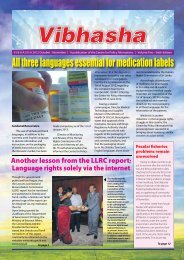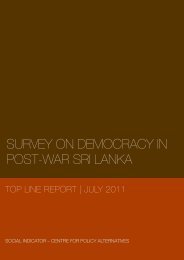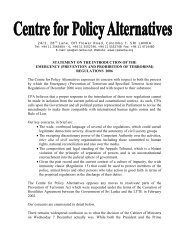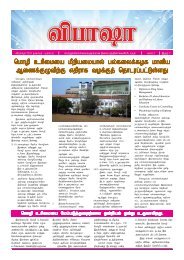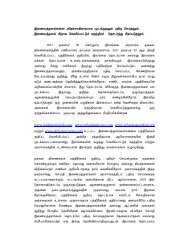- Page 1 and 2:
A State of Permanent Crisis Constit
- Page 3 and 4:
This book is dedicated to J.S. Tiss
- Page 5 and 6:
3.
The
Neo‐Roman
Cons
- Page 7 and 8:
6.
Fundamental
Rights
....
- Page 9 and 10:
security has been prioritised and t
- Page 11 and 12:
The year 2008 also marks the twenty
- Page 13 and 14:
nationalist political ideology (mir
- Page 15 and 16:
Needless to say, responsibility for
- Page 17 and 18:
those who believe in the democratic
- Page 19 and 20:
the exception discussed below. None
- Page 21 and 22:
independence or capacity to ensure
- Page 23 and 24:
einterpretation of its constitution
- Page 25 and 26:
issues from comparative experience
- Page 28: PART
I
The Theory and Practice
- Page 31 and 32: In their recent comprehensive study
- Page 33 and 34: in the process, destroy democracy.
- Page 35 and 36: appointment of a dictator according
- Page 37 and 38: dictator. 15 The dictator enjoyed a
- Page 39 and 40: was the cultural and political etho
- Page 41 and 42: siege is therefore a legal institut
- Page 43 and 44: In Dicey’s view, the idea of mart
- Page 45 and 46: diminish, the acknowledged prerogat
- Page 47 and 48: Legislative
Accommodation One of
- Page 49 and 50: judges to resolve competing claims
- Page 51 and 52: other vastly disparate contextual r
- Page 53 and 54: than undermine, the rule of law in
- Page 55 and 56: Carl
Schmitt:
Sovereign
Di
- Page 57 and 58: Schmitt thought that, “…liberal
- Page 59 and 60: The centrepiece of Schmitt’s mode
- Page 61 and 62: exception has been declared by the
- Page 64 and 65: CHAPTER
III THE
NEO‐ROMAN
C
- Page 66 and 67: 3.1
Comparative
Experience:
- Page 68 and 69: of emergency. It is true that the d
- Page 70 and 71: emergency’. 87 The former remains
- Page 72 and 73: legislation for the peace, order an
- Page 74 and 75: the problem of deLinition plagues t
- Page 76 and 77: to undertake, these jurisdictions m
- Page 80 and 81: may override ordinary statutes. As
- Page 82 and 83: natural disasters, and a negative l
- Page 84 and 85: However, the signiLicance of this p
- Page 86 and 87: demonstrate this. 137 Other federat
- Page 88 and 89: two classic constitutional devices
- Page 90 and 91: may be curbed by the judiciary.”
- Page 92 and 93: each department the necessary const
- Page 94 and 95: normative expectations of the accom
- Page 96 and 97: proved able, or indeed willing, to
- Page 98 and 99: executive powers, and indeed tolera
- Page 100 and 101: so clearly and blatantly transgress
- Page 102 and 103: conLlict, but the character of the
- Page 104 and 105: who use them to attack or undermine
- Page 106 and 107: to the thoughts, feelings, and ener
- Page 108 and 109: executive in favour of the latter,
- Page 110 and 111: CHAPTER
IV STANDARDS
GOVERNING
- Page 112 and 113: The past Live decades - the post Wo
- Page 114 and 115: adaptation in human rights law of t
- Page 116 and 117: interpreting these provisions. Subs
- Page 118 and 119: interpreted this to mean “…a si
- Page 120 and 121: were the result of an initiative by
- Page 122 and 123: All three instruments contain a lis
- Page 124 and 125: that it would “…take a State pa
- Page 126 and 127: ‘views’ are dependent on the at
- Page 128 and 129:
terms, but also that it provides fo
- Page 130 and 131:
incomplete reports. Perhaps unsurpr
- Page 132 and 133:
has also issued guidelines regardin
- Page 134 and 135:
advocacy role for its own views, wi
- Page 136 and 137:
The relevant State Party has an opp
- Page 138 and 139:
Nothing turns on the question wheth
- Page 140 and 141:
these rights. Derogation involves p
- Page 142 and 143:
ights under any circumstances, and
- Page 144 and 145:
population, to the territorial inte
- Page 146 and 147:
neither the ECHR nor the ACHR syste
- Page 148 and 149:
proclaimed a state of emergency. Th
- Page 150 and 151:
proportionate, in addition to confo
- Page 152 and 153:
elation
to
the
termination
- Page 154 and 155:
ut also the deeply conceptualised b
- Page 156 and 157:
Covenant (e.g., articles 6 and 7).
- Page 158 and 159:
Statute of the International Crimin
- Page 160 and 161:
derogability.
Even
in
time
- Page 162 and 163:
national security, and the protecti
- Page 164 and 165:
The Human Rights Committee has repe
- Page 166 and 167:
equires that States parties provide
- Page 168 and 169:
The only occasion in which the Huma
- Page 170 and 171:
would entail a breach of the State
- Page 172 and 173:
PART
II
The Sri Lankan Experie
- Page 174 and 175:
CHAPTER
V SRI
LANKA’S
CON
- Page 176 and 177:
emergency without having to look ov
- Page 178 and 179:
A state of emergency is brought int
- Page 180 and 181:
Chapter XVIII was predicated on the
- Page 182 and 183:
Regulations No. 1 of 2005 286 and E
- Page 184 and 185:
that of the person committing the a
- Page 186 and 187:
mens
rea
requirement for any
- Page 188 and 189:
extraordinary powers to the executi
- Page 190 and 191:
of almost every human rights norm 2
- Page 192 and 193:
question whether executive law‐ma
- Page 194 and 195:
merits as well as the statement of
- Page 196 and 197:
struck down a detention order after
- Page 198 and 199:
ecognised in Article 15 may be vali
- Page 200 and 201:
its underlying policy and motivatio
- Page 202 and 203:
Firstly, the problem of the deLinit
- Page 204 and 205:
extension requires a special majori
- Page 206 and 207:
ebellion, the President is empowere
- Page 208 and 209:
CHAPTER
VI FUNDAMENTAL
RIGHTS 6
- Page 210 and 211:
Permissible restrictions on these r
- Page 212 and 213:
6.2.1
Structure
and
Content V
- Page 214 and 215:
eLlection of the high importance ac
- Page 216 and 217:
unduly conservative and restrictive
- Page 218 and 219:
Lilanthi
de
Silva
v.
The
- Page 220 and 221:
provided for by the ICCPR Article 4
- Page 222 and 223:
suppressing opposition aimed at suc
- Page 224 and 225:
considerably diverge from, and in s
- Page 226 and 227:
The court’s reasoning with regard
- Page 228 and 229:
embrace judicial activism, in not o
- Page 230 and 231:
With regard to the Linding of uncon
- Page 232 and 233:
own judgment in Singarasa
reLlect
- Page 234 and 235:
legal assistance, interpreter and s
- Page 236 and 237:
CHAPTER
VI CONCLUSION “…unsee
- Page 238 and 239:
certain commitments, and then actin
- Page 240 and 241:
TABLE
OF
CASES A
Publication
- Page 242 and 243:
Nagamani
Theivendran
v.
Th
- Page 244 and 245:
PROCLAMATIONS
AND
EMERGENCY
- Page 246 and 247:
Yala National Park Regulation 7 of
- Page 248 and 249:
Establishment of a new Department o
- Page 250 and 251:
BIBLIOGRAPHY A Bruce Ackerman (2004
- Page 252 and 253:
J.A.L. Cooray (1995) Constitutional
- Page 254 and 255:
European Commission for Democracy t
- Page 256 and 257:
Oren Gross and Fionnuala Ní Aolái
- Page 258 and 259:
K Robert N. Kearney (1971) Trade
- Page 260 and 261:
Herbert Marx (1970) ‘The
Emerg
- Page 262 and 263:
Eugene V. Rostow (1945) ‘The
Ja
- Page 264 and 265:
UN Special Rapporteur on the Indepe



